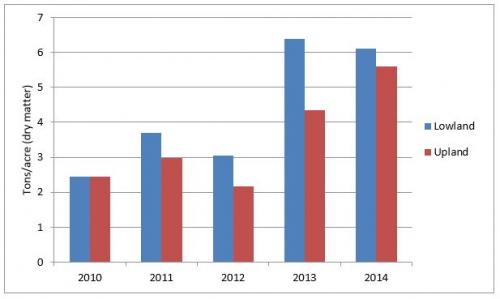Switchgrass

Switchgrass (Panicum virgatum L.) is a warm season grass, native to Central and North American tall grass prairies. Switchgrass has gained a great deal of momentum as an energy crop due to its high biomass yield potential and relatively low input needs. Also, its C4 photosynthetic pathway makes it an efficient user of water. Switchgrass can be grown on marginal (less productive) lands that are not used for food crop production, thereby giving it an advantage in the eyes of society.
Research Reports
Variety Selection
There are two ecotypes (lowland and upland) of switchgrass. Lowland varieties tend to perform well in the southern United States where the growing season is longer and temperatures are warmer. Upland varieties are more tolerant to cold temperatures and have higher winter survivability than lowland ecotypes. Selecting high yielding varieties of the appropriate ecotype will be very important to the successful production of switchgrass. Consult your local Extension office for yield data in your area.
Upland
- Trailblazer
- Blackwell
- Cave-in-Rock
- Pathfinder
- Carthage
Lowland
- Alamo
- Kanlow
- Summer
Stand Establishment
Switchgrass seed should be planted into a firm, tilled seedbed. Success with no-till establishment has been variable at best. Weeds should be controlled prior to tillage. A burndown application of glyphosate works well. The optimum seeding depth is ¼ to ½ inch. If you plant any deeper, it will likely result in a stand failure.
The target seeding date varies with latitude. As a general rule, you should seed between May and mid-June. It is important to plant into a warm, moist soil. Weeds can also be a problem in these conditions. That’s why it is important to control weeds prior to seedbed preparation. Hot, dry conditions after planting will stress seedlings and provide weeds an advantage.
A seeding rate of 8 pounds of pure live seed (PLS) is recommended for a successful stand. Reputable seed dealers will sell you seed based on PLS and it will be printed on the tag what percent is PLS. Suppose you purchase a bag of seed that is 90 percent PLS. You would calculate the amount of seed to plant as 8 divided by 0.90 or 8.88 pounds (8 ÷ 0.9 = 8.88). It is important that you plant 8 pounds of PLS.
Fertility
Soil testing is an important first step to providing the proper amounts of nutrients. Soil should be limed to a minimum pH of 6.0. Some grasses can tolerate pH levels much lower, but for optimum nutrient availability and maximum yield potential, you should maintain a pH of 6.0. Phosphorus and potassium should be applied based on soil test results.
Links
Switchgrass as a Biofuel for Michigan (Extension Bulletin E-2987)




 Print
Print Email
Email